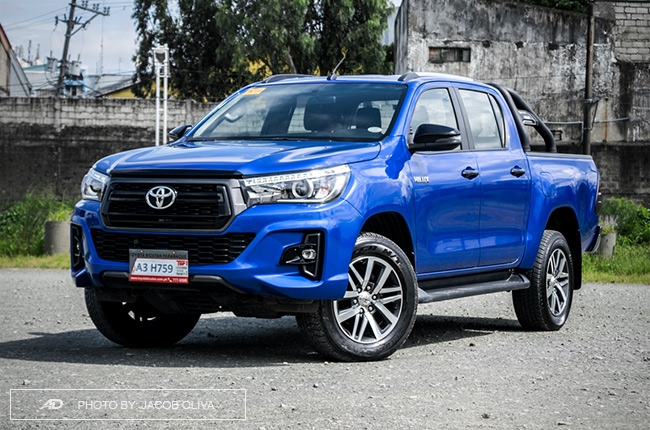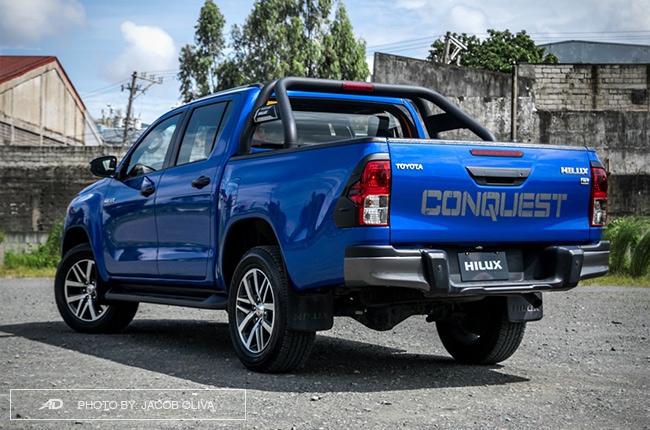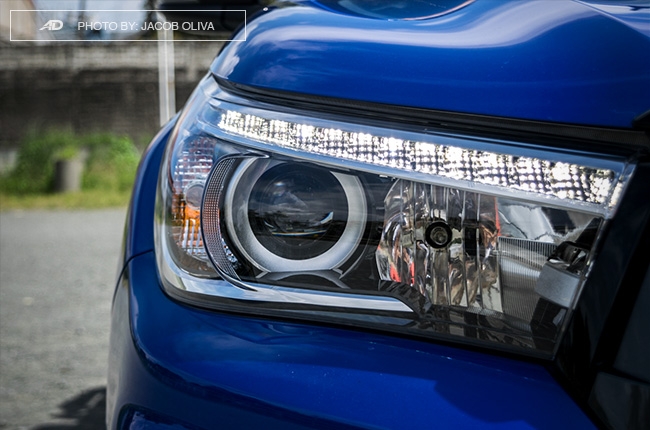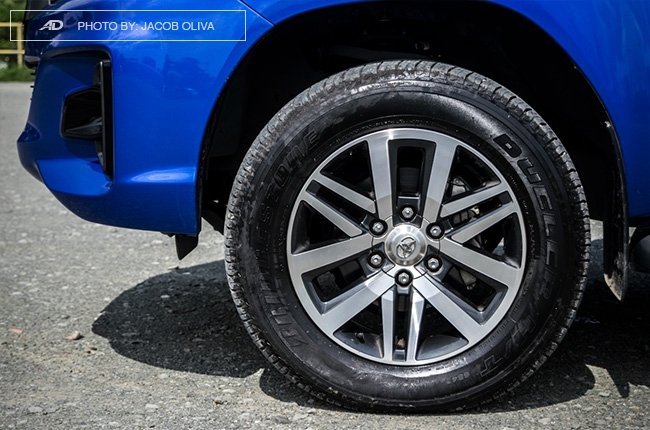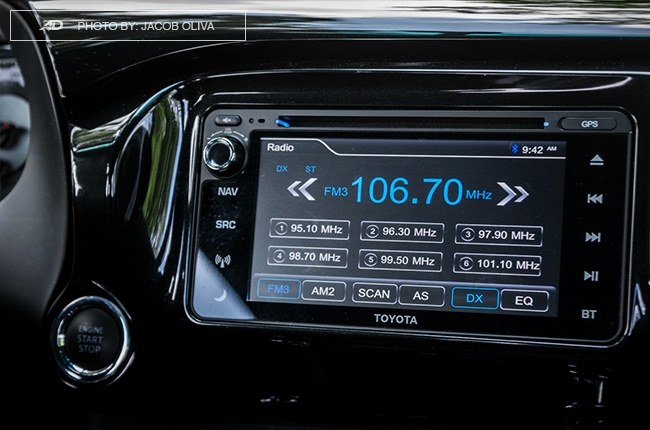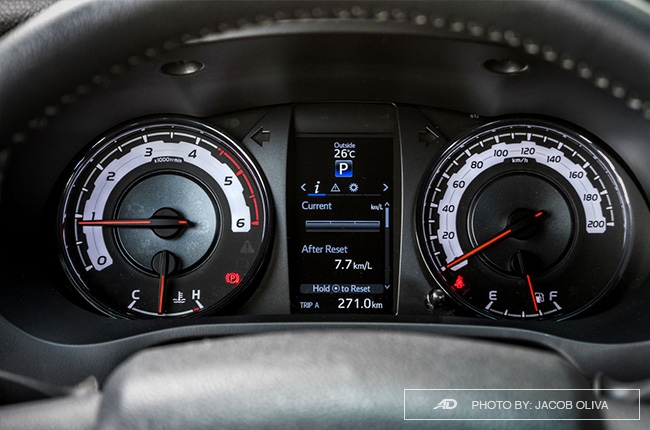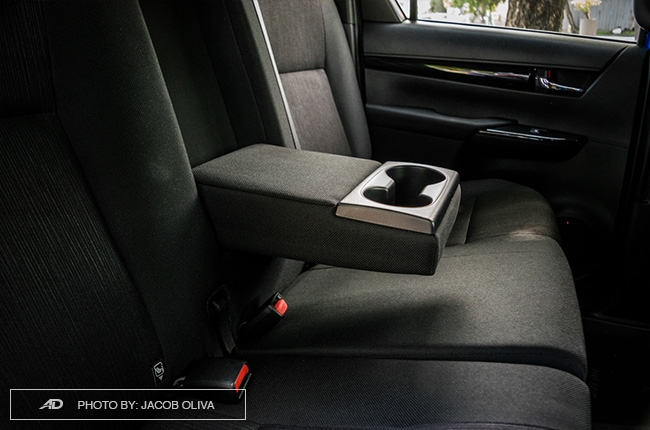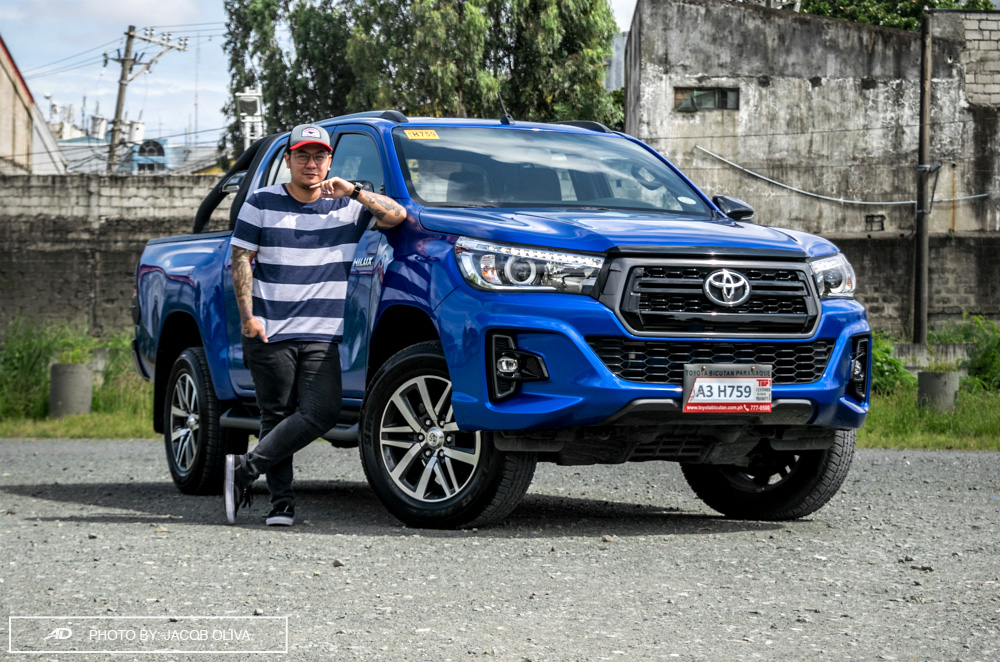
Ah, yes. The Hilux – one of Toyota’s long-withstanding nameplates. Ever since the early 90s, this pickup truck has been roaming the Philippine streets, which makes it a name that most Filipinos are familiar with. But familiarity comes with a curse – the Hilux’s design doesn’t stand out. It lacks flair, or as Filipinos put it, kulang sa angas.
I used to agree with the majority until Toyota Motor Philippines brought in the Hilux Conquest. This new top-spec trim in the Hilux range is obviously a huge derivation in terms of design, and for the first time, a Hilux can turn people’s head. Which leads to the next question: do the Hilux Conquest’s qualities stand by its extensive aesthetic updates? We had one for several days to find out.
Engine Output (HP), Acceleration, Transmission, Handling 4.0/5
Exterior & Interior Design, Quality, Fit and Finish, Ergonomics 4.5/5
Cabin Comfort, Suspension, NVH Insulation 3.5/5
Convenience Technologies, Active and Passive Safety Features 4.0/5
Amount of the vehicle you get for the price, Fuel Efficiency 3.5/5
- Solid design makeover.
- Powerful yet fuel-efficient engine.
- Interior space is more than sufficient.
- Ride's a bit rough compared to other pickup trucks.
- Materials used inside the cabin.
- Its price point.
Let’s start with the Hilux Conquest’s biggest asset – its undeniably head-turning design. It’s as if the Hilux bought a new set of clothes to be more appealing, striking, and pleasing to the eyes. It’s a total makeover, one that Project Runway’s Tim Gunn would be proud of. I particularly like the way Toyota dropped the chromes, and then slapped a huge hexagonal grille with honeycomb background on its fascia.
The host of LED lighting and sinister-looking daytime running lights complement the new sporty look, putting this variant at par, if not better than the other nameplates in its segment.
Aside from its front fascia, what separates the Hilux Conquest from the rest of the normie Hiluxes are the sports roll bar, roof ornaments, bed liner, 18-inch alloys, and the “Conquest” graphic on the tail. Okay, frankly, I’m not a fan of the graphic, specifically its font face. It just doesn’t make the cut. Nevertheless, I love the Conquest-exclusive Nebula Blue Metallic color of the media unit, so I guess I can live with that (or just have it removed).
To set things straight, though, the Conquest trims are pumped-up G variants in the Hilux range and not an all-new model. But the changes aren’t subtle, it could trick people into thinking that. In fact, the design’s jump from the non-Conquest variants is so huge, it’s like a leap between two skyscrapers. It’s a scary feat, something that can either go against or for Toyota. Now if you ask me if the company was able to make the leap, I honestly think it did.
Inside, the host of changes isn’t extensive. It has the same curvy layout as the regular Hilux, except one – the silver accents are replaced by piano black plastics. It’s a youthful look, which is unlikely in a pickup truck, but as I’ve said many times before, piano black plastics deteriorate quickly and is extremely prone to scratches.
If I were to nitpick further, the materials used on some parts of the cabin could be better. Aside from the mentioned piano black accents, there are some hard plastics, which is a surprise considering this vehicle’s price point. Seats are upholstered with cloth, too, but that’s fine since it felt nice to the touch.
As with regular Hiluxes, certain elements of the dashboard are carried over from its SUV brother, the Fortuner. These are the steering wheel with audio, call, and multi-information display controls; the 6.5-inch infotainment system with seamless smartphone pairing; and the automatic air-conditioning controls. All of these are intuitive, easy to use, and within arms’ reach.
The Hilux Conquest is also gifted with conveniences such as speed-sensing door locks, parking sensors, power-folding side mirrors, and automatic headlights. The latter’s a bit odd, though, as it can’t be toggled off and its sensors are a bit sensitive. You’ll likely find your headlamps switched on when it gets dark prior to a rainfall.
Just like modern pickup trucks, space is abundant inside the Hilux. It’s not as roomy as the Ford Ranger or Chevrolet Colorado, but it’s enough to seat five people of my height (5’6”) and built (medium). The rear seats are comfortable but not well-bolstered, and there are no rear A/C vents, but that’s fine since the climate control can quickly cool the entire cabin.
What I appreciate best with the Hilux is the presence of four hooks in the rear cabin. It can hold backpacks, purses, shopping bags, and other things, while can also serve as utility hooks just in case you want to use the rear cabin as a storage space. The rear seats can be folded up, too. Pretty nifty.
Given the improvement in the ride quality of pickup trucks over the years, the Hilux’s isn’t one of the greatest out there. It’s stiff when compared to its rivals, which is something Toyota can improve on its next iteration. Good thing, finding the perfect driving position is a cinch with its height-adjustable driver seat and telescopic steering wheel, and sound isolation works well to keep engine and road noise outside the cabin.
The Hilux Conquest media unit that I had is the G 4x4 AT. As a 4x4 variant, it houses a 2.8L turbocharged 1GD-FTV engine under its hood, pushing 174 horses and 450 Nm torque to the rear wheels when 4x4 isn’t on. These numbers are smaller than what its mentioned rivals can produce, however, it didn’t feel that way on the actual drive. I absolutely love how it behaves on the road.
The engine responds quickly to accelerator inputs, and low-end torque is urgently felt with every command. Changing speeds is also welcome as the six-speed transmission shift smoothly and delivers the power quickly. It does come with an option to manually shift the gears, but I didn’t feel the need to do so. Overall, the Hilux performed like how pickup trucks should be – powerful, reactive, and won’t leave you wanting for more.

In terms of handling, the Hilux’s steering wheel feels tight, but there’s a certain amount of joy in this at it accounts for precise handling. Tight city maneuvers isn’t a problem, too, as the steering feels lighter on low speeds. Combined with its wide cabin visibility, it makes maneuvering this relatively huge machine painless and safe.
Speaking of safety, the Hilux Conquest comes with a host of safety features as a top-spec variant. These include front, side, and curtain airbags, stability control, traction control, brake assist, ABS with EBD, and ISOFIX child seat anchors.

Even with the Hilux’s weight, the 2.8L delivered great fuel efficiency numbers. Highway stints at an average 90 km/h read 14.4 km/L, while crawling in heavy city traffic at 15 km/h average clocked in 7.2 km/L. Faster city paces at 60 km/h, which is rather seldom, registered 10.2 km/L.
The Toyota Hilux Conquest 2.8 G 4x4 AT has a price tag of P1,777,000. Yes, yes, we hear you. It’s a bit steep when compared to its competitors. In fact, it’s now the most expensive in its class, even higher than the top-spec Ford Ranger Wildtrak. Admittedly, it’s also at the shorter end of the stick because of this price tag by lacking some features that are available in its lower-priced rivals like cruise control, reverse camera, and 360-degree camera, among others.
But, with its great driving characteristics, host of features, and solid exterior design, it’s worth considering if you’re shopping for a pickup truck. Besides, it’s a Toyota, and this brand name comes with a value that you’ll feel three to five years into vehicle ownership. Think about that.
Specifications
Engine
2.8 LFuel Type
DieselPerformance
201 hp @ 3,400 rpmTransmission
Automatic-
Summary
-
Name Toyota Hilux Conquest 2.8 DSL 4x4 AT Body Type Pickup Truck Price ₱2,084,000 Transmission Category Automatic -
Engine
-
Engine Size 2.8 L Displacement 2,755 cc Number of Cylinders 4 Number of Valves 16 Transmission Type 6-Speed Automatic Transmission -
Performance
-
Drivetrain Four-Wheel Drive Max Output (hp) 201 hp @ 3,400 rpm Max Torque (nm) 500 Nm @ 1,600 rpm -
Economy & Environment
-
Fuel Type Diesel Emissions Standard Euro 4 Fuel Capacity 80.0 L *Combined Fuel Consumption 12.0 km/L *brand manufacturer claim
-
Dimensions
-
Length 5,325 mm Width 2,020 mm Height 1,845 mm Wheelbase 3,085 mm Deck Length 1,525 mm Deck Width 1,540 mm Deck Height 480 mm Payload Capacity 1,050 kg Turning Circle 13 m Ground Clearance 279 mm Trunk Capacity n/a Number of Doors 4 Number of Seats 5 -
Safety & Security
-
Driver's Airbag 1 Front Passenger's Airbag 1 Side Airbag 2 Curtain Airbag 2 Knee Airbag 1 Auto Brake System Electronic Brake Distribution Anti-lock Brake System (ABS) with Electric Brake-force Distribution with Brake Assist
Immobilizer Security Alarm Stability Control Electronic Door Locks Speed Sensing Door Locks ISOFIX Lane Departure Warning System Blind-Spot Detection System -
Features
-
Cruise Control Front Parking Sensors Rear Parking Sensors Leather Upholstery Push Start Button Wheel Size 18 in Wheels Metal Type Alloy Airconditioning System Dual Zone Automatic Climate Control Entertainment System 9" Display Audio with 6 speakers Connectivity AM/FM/Bluetooth/USB/Apple Carplay (Wireless) /Android Auto (Wireless) Navigation Ready Warranty 3-years (100,000 km) Keyless Entry Roof Rack Sunroof Electric Adjustable Seats Power Steering Power Windows Power Outlet Steering Wheel Audio Control -
Technology
-
Active Park Assist Hill Start Assist AWD Modes Four-Wheel Drive Tire Pressure Monitoring Heads-up Display Power Liftgate Start-stop System
Colors
Latest Review
-
Addictively excessive: The Ford Ranger Raptor Twin Turbo V6 / Review
The Ford Ranger Raptor Twin Turbo V6 is one crazy pickup truck. Wondering why? Just keep reading.
4.6 / 5 -
The Kia Carnival gives you more: More seats, more comfort, and more practicality / Review
The Kia Carnival is a three-row MPV designed for executives and families. It combines comfort, technology, and practicality, making it a strong choice for those looking for a premium people...
4.2 / 5 -
The Jetour Ice Cream: A pint-sized EV that’s hard to ignore / Review
The Jetour Ice Cream is an adorable, pint-sized electric car that’s made for the city. Affordable and stylish, it’s easy to love, but does it tick all the boxes for you?
3.7 / 5
Popular Articles
-
Cheapest cars under P700,000 in the Philippines
Jerome Tresvalles · Sep 02, 2024
-
First car or next car, the Ford EcoSport is a tough package to beat
Jun 18, 2021
-
Car Maintenance checklist and guide – here’s everything you need to know
Earl Lee · Jan 12, 2021
-
Most fuel efficient family cars in the Philippines
Bryan Aaron Rivera · Nov 27, 2020
-
2021 Geely Okavango — Everything you need to know
Joey Deriquito · Nov 19, 2020
-
Family cars in the Philippines with the biggest trunks
Sep 20, 2023
-
Head to head: Toyota Rush vs. Suzuki XL7
Joey Deriquito · Oct 28, 2020
-
Why oil changes are important for your car
Earl Lee · Nov 10, 2020
-
2021 Kia Stonic — What you need to know about it
Joey Deriquito · Oct 16, 2020
-
Top 7 tips for buying a used car in the Philippines
Joey Deriquito · Nov 26, 2020

